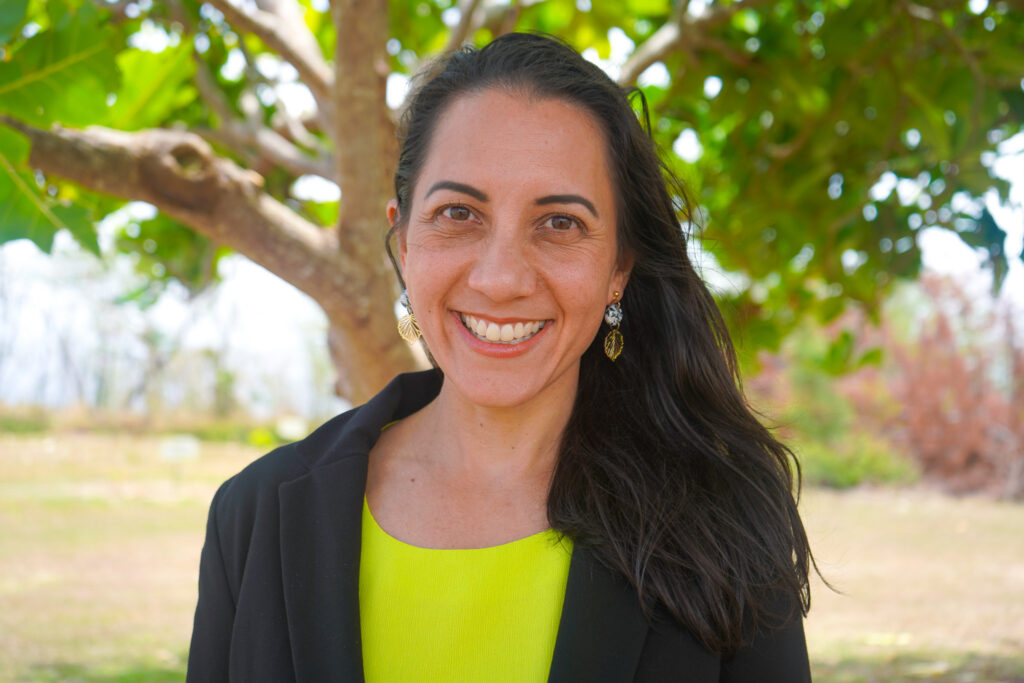Written by Kristi Hammond

Tanisha F. Aflague, PhD, RDN graduated with her doctoral degree in Nutritional Sciences from the University of Hawai’i at Mānoa and was part of the Children’s Healthy Living (CHL) Center’s inaugural training program cohort. She is now an Associate Professor of Nutrition at the University of Guam’s (UOG) College of Natural & Applied Sciences (CNAS) where she has taught graduate and undergraduate level courses in numerous nutrition topics including Community Nutrition, Nutritional Epidemiology, Nutritional Assessment, Advanced Human Nutrition, Nutrition Education and Counselling, Public Health Nutrition, and Medical Nutrition Therapy. In addition, she is the Expanded Food and Nutrition Education Program (EFNEP) and Supplemental Nutrition Assistance Program – Education (SNAP-Ed) Coordinator at the UOG Cooperative Extension & Outreach.
Describe the evolution of your involvement with CHL from your time as a trainee to your current role today.
A former CHL trainee, I gradually entered into the role as Guam CHL lead for the CHL Center and now CHL Food Systems, where I oversee CHL-related research and extension activities in Guam. In my role as the Guam SNAP-Ed coordinator, I help to sustain the 5 of the 6 CHL target behaviors (i.e., physical activity, sedentary behavior, fruit and vegetable intake, sugar-sweetened beverage intake, and water intake) through the collective impact of Guam SNAP-Ed projects approved by USDA, FNS. We have continued social marketing campaigns and have expanded the Food Friends and Mighty Moves curriculum (from daycare into all Guam Head Start classrooms). These are some of the legacies of CHL still being implemented today.
I am also one of the CHL Network (CHLN) Multi-state project leads, where I am involved in collaborative research that leverages existing datasets shared across the CHL jurisdictions, extension research to advance community programs and resources, and training to increase access to Pacific-based resources to underrepresented populations. Additionally, I have had the opportunity to create new partnerships with researchers in the US-affiliated Land Grant College system beyond the CHL jurisdictions to engage in novel research opportunities to address health disparities among Pacific Islanders.
Reflecting on your journey from being a trainee to your current role, what key skills or experiences gained during the CHL training program have been most beneficial?
During my time as a trainee, we received hands-on training and exposure to the principles and components of community-based multi-level interventions. We were trained in data collection, entry, and analysis — skills and tools I have been able to continue to use today. For instance, I’ve been able to apply standardized training in anthropometry and assessment of acanthosis nigricans in several other research projects I have been involved in. The resources provided by CHL has helped to build/extend capacity to standardize other researchers in Guam — a ‘train the trainer’ approach. Additionally, I honed my skills as a trained facilitator (conducted by Donna Ching) during community engagement meetings and institutional strategic planning meetings.
Our CHL seminars were a collective of undergraduate and graduate student trainees from across the Pacific. This experience was culturally grounding, and I became even more mindful of the similarities and differences of our Pacific cultures. I was able to infuse my own cultural knowledge and experiences into my dissertation while receiving mentorship from my advisor Dr. Carol Boushey in research related to Technology Assisted Dietary Assessment (TADA) research at the UH Cancer Center. The diverse cultures and lived experiences among my CHL mentors also expanded my cultural competence as I learned about other indigenous cultures beyond the Pacific. In reflection, my academic journey was an immersion of cultural awareness and research methodology, which continues to guide me today.
How has the educational support provided during the trainee program influenced your career path and development?
CHL afforded me the opportunity of a terminal degree tuition-free. I am now able to actively contribute to the education and training of nutrition students, paraprofessionals, and future dietitians – a rewarding alternative for not being a current practicing dietitian, which I consider my roots.
With the introduction of community-based participatory research (CBPR) provided by CHL, I have deepened my appreciation for through practice in my pursuit of using CBPR in every opportunity I get, especially in my extension and research endeavors. Through my education, I really gained an appreciation and newfound love for CBPR approaches. This is the work I am excited to continue.
What is your current vision for building capacity in Guam around nutrition?
I hope to continue contributing to the training of future dietitians in the region by collaborating with other institutions such as UH Mānoa to produce RD-eligible students. In addition, I envision continuing to harness and build upon the EFNEP paraprofessional model – equipping and training individuals who are from and know the communities they serve best with skills and training in nutrition content knowledge. This model has been very effective in delivering resources and education to the community and is a framework I believe can be adapted for other programs.
In continuing to build capacity in Guam around nutrition, I want to emphasize the message of ‘Going local’ – really uplifting our local food system and the people and communities involved in the production and preparation of our food (the farmers, the producers, those involved in preparing and processing food). Operationalizing this vision is my perspective to ensure a resilient food system that promotes nutrition and food security from our lands, seas, air, and people.
What advice would you give for someone who is considering pursuing a doctoral degree in nutrition?
Be true to who you are and pursue your passions.
